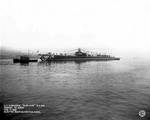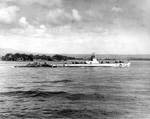![Albacore file photo [1092] Albacore file photo [1092]](/images/ship_albacore1.jpg)
Albacore
| Country | United States |
| Ship Class | Gato-class Submarine |
| Hull Number | SS-218 |
| Builder | Electric Boat Company |
| Laid Down | 21 Apr 1941 |
| Launched | 17 Feb 1942 |
| Commissioned | 17 Feb 1942 |
| Sunk | 7 Nov 1944 |
| Displacement | 1,526 tons standard; 2,424 tons submerged |
| Length | 312 feet |
| Beam | 27 feet |
| Draft | 15 feet |
| Machinery | Genteral Motors diesel electric engines, two screws |
| Bunkerage | 97,140 gallons, two 126-cell main storage batteries |
| Power Output | 5,400 shaft horsepower |
| Speed | 20 knots |
| Range | 11,000 nm at 10 knots |
| Crew | 60 |
| Armament | 10x21-in torpedo tubes, 1x3-in gun, 4 machine guns |
| Submerged Speed | 8.75 knots |
Contributor: C. Peter Chen
ww2dbaseSponsored by the wife of Captain Elwin F. Cutts, Albacore was the submarine credited with scoring torpedo hits on the Japanese aircraft carrier Taiho during the Battle of the Philippine Sea which led to the eventual sinking of the ship. Interestingly, the Americans did not realize the carrier had sunk until months later; Lieutenant Commander James W. Blanchard eventually received a Navy Cross for the sinking. She left Pearl Harbor on 24 Oct 1944 on her 11th patrol, and stopped at Midway for refueling four days later. After which, she was reported missing at sea. Post war study of Japanese records assumed that the American submarine sunk off Hokkaido on 7 Nov 1944 by a naval mine was Albacore.
ww2dbaseBy the time of her final patrol, Albacore was credited with sinking 74,100 tons of Japanese shipping. Her score card, besides the carrier Taiho, also included three other warships (two destroyers and a light cruiser).
ww2dbaseSource: Wikipedia.
Last Major Revision: Nov 2005
Submarine Albacore (SS-218) Interactive Map
Photographs
 |  |  |
Albacore Operational Timeline
| 17 Feb 1942 | Albacore was commissioned into service. |
| 18 Dec 1942 | USS Albacore sank Tenryu between Madang, Australian New Guinea and Truk, Caroline Islands. |
| 19 Dec 1942 | USS Albacore returned to the site of Tenryu's sinking, which took place on the previous day, and observed wooden crates, 85 empty oil drums, and other debris floating in the water. |
| 19 Jun 1944 | At dawn, flagship Taiho, Shokaku, and Zuikaku launched launched combat air patrol fighters. At 0756 hours, the first major strike force was launched (48 fighters, 53 bombers, and 27 torpedo bombers; led by Lieutenant Commander Akira Tarui). At 0810 hours, USS Albacore hit Taiho with a torpedo in the starboard bow, but Taiho's damage control team allowed the carrier to remain in formation; destroyer Hatsuzuki was left behind to hunt for USS Albacore. At 1020 hours, Zuikaku launched a second strike force (4 fighters and 4 bombers) to join the fourth big raid on on US Navy Task Force 58. Meanwhile, Taiho suspended flight operations due to gas vapor issues and Shokaku was busy with combat air patrol duties through well past 1100 hours. At 1100 hours, Shokaku began recovering 10 fighters; while the recovery process continued, at 1122, Shokaku was hit by three torpedoes from USS Cavalla on the starboard side; two forward near the switchboard and generator room, one aft of amidships. Large fuel fires were ignited in the hangar and No. 1 boiler room went offline. Shokaku remained underway, but began to list to starboard. Counterflooding over-compensated, giving her a port list. Meanwhile flooding and heat of the fires forced shutting down of the boiler rooms. She continued to settle forward. Though damage control initially hoped to save her, the flooding forward and the fires intensify in the following hours. By 1210 hours Shokaku had come to a halt when fires detonate an aerial bomb on the hangar, setting off volatile gases from a cracked forward tank. Large induced explosions wrecked the carrier, and hope began to fade. The list to port and bow trim both increased. Carriers Zuikaku and Taiho were ordered to leave damaged Shokaku behind, while cruiser Yahagi and destroyer Urakaze remained with Shokaku. At 1350 hours, Shokaku strike planes returned, but were ordered away, redirected to Zuikaku and Taiho. By the time Taiho's aircraft returned, the gas vapor leak problem became extremely worrisome, and some of Taiho's aircraft were redirected to Zuikaku. At this time Captain Hiroshi Matsubara of Shokaku had ordered the carrrier abandoned and the crew mustered on the flight deck for flag lowering. However, before the evacuation can proceed far, the bow dipped under and water pours into No. 1 elevator well, causing the carrier to corkscew to port and up-end. Shokaku went down by the bow at 1401 hours, stern raised high. Between 1408 and 1411, four underwater explosions were registered. 58 officers, 830 petty officers and men, 376 members of Air Group 601, and 8 civilians were killed, totalling 1,272 deaths in the sinking of Shokaku. Light cruiser Yahagi and destroyers Urakaze and Hatsuzuki rescued Captain Hiroshi Matsubara among 570 other survivors. At 1432, another disaster struck as the gas vapor aboard Taiho detonated; the explosion engulfed the flagship. Zuikaku was ordered to proceed while Vice Admiral Jisaburo Ozawa to transferred his flag to cruiser Haguro. At the end of the day, the Japanese Navy lost 244 of the 374 aircraft that it had launched during this battle. The US Navy had only lost 20 aircraft. |
Please consider supporting us on Patreon. Even $1 per month will go a long way! Thank you. Please help us spread the word: Stay updated with WW2DB: |
» Mariana Islands Campaign
Partner Sites Content:
» Albacore Submarine Operations Research Group Attack Data
- » 1,170 biographies
- » 337 events
- » 44,835 timeline entries
- » 1,244 ships
- » 350 aircraft models
- » 207 vehicle models
- » 376 weapon models
- » 123 historical documents
- » 261 facilities
- » 470 book reviews
- » 28,518 photos
- » 365 maps
Winston Churchill
Please consider supporting us on Patreon. Even $1 a month will go a long way. Thank you!
Or, please support us by purchasing some WW2DB merchandise at TeeSpring, Thank you!












